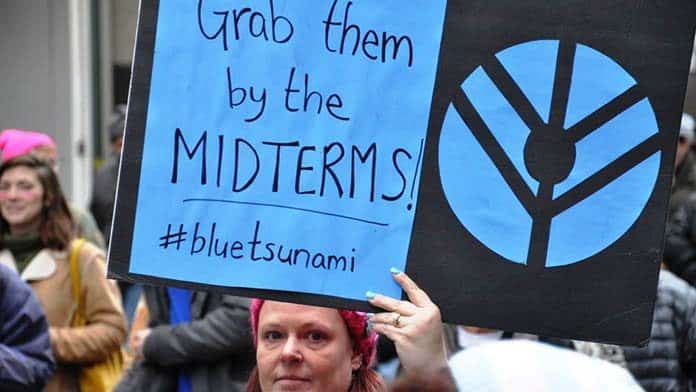The Democratic Party made big gains in US mid-term elections on 6 November, in what was widely seen as a referendum on Donald Trump.
Ever since he won office, the Democrats have set their sights on the midterms. Their hope was that two years living under Trump would help them unseat enough Republicans to win back control of the House of Representatives—and in that they succeeded. The Republicans, however, retained control of the Senate.
The results confirm there is a huge audience who hate Trump and the Republicans. This “blue wave” of Democrat wins has let the party breathe a sigh of relief, but the fight against Trump and his agenda is far from won.
The Democrats are now preparing for the 2020 presidential election. But Trump just put a known sexual abuser and anti-choice bigot on the Supreme Court, told the army to open fire on the migrant caravan approaching the US-Mexico border, and plans to write transgender people out of legal existence. The worst anti-semitic attack in US history was carried out by a murderer inspired by Trump’s politics. Change can’t wait until 2020.
Resistance from below
The lead-up to the elections was marked by inspiring anti-Trump resistance on the streets. Survivors of sexual violence, women, and their supporters stood up to Trump’s Supreme Court nominee Brett Kavanaugh.
Although he successfully won the seat, mass civil disobedience in Washington DC and marches around the country leading up to his confirmation showed the kind of power ordinary people have to beat back Trump’s agenda.
Two brave survivors of sexual violence confronted Jeff Flake, the Arizona Senator who held a decisive vote, in an elevator during the Senate hearings on the nomination. Virginia activists, including a teacher strike leader, staged a sit-in at the office of Joe Manchin, the one Democrat who shamefully voted to confirm Kavanaugh. Together these actions forced the government to call a week-long FBI investigation into the attempted rape allegations.
Those of us in the anti-Kavanaugh resistance got a sense of our own power that week. Across the country we gave and listened to speeches about how we would never again be silenced by the powerful men who abuse us. But mainstream women’s rights organisations dragged their feet calling large actions and the Democrats’ only offering to defeat structural sexism and defend abortion rights was to wait for the elections. It felt like most on-the-ground resistance was cancelled until after November, our inboxes filling up with get-out-the-vote messages.
Democratic Socialists
Some of this resistance has been channelled into supporting left-wing candidates like New York’s Alexandria Ocasio-Cortez and Julia Salazar—who ran as socialists on platforms against ICE (Immigration and Customs Enforcement) and for universal healthcare. During the primaries earlier this year, Ocasio-Cortez unseated corporate Democrat Joe Crowley. This win gave hope to tens of thousands of people disgusted with the Trump presidency and the feeble resistance most Democrats have offered over the last two years.
The candidates who won on left-wing platforms show the audience for the left. But Ocasio-Cortez’s win also demonstrated a problem.
Once pre-selected, she has quietly distanced herself from her socialist backers, the Democratic Socialists of America. Her original anti-ICE position changed to an argument to reform border control. When questioned on Palestine, she sided with Israel. In the midterms she campaigned for the kinds of centrist Democrats that she defeated in her primary.
Another Democratic Socialist, Lee Carter, was an exciting prospect when he won local elections in Virginia a year ago. But he recently voted for a medicaid expansion that was contingent on work-for-the-dole. He could have refused on principle. But once elected there is huge pressure to be pragmatic and play the political game, even if it means making concessions to the right.
This is the inevitable outcome for progressive Democrats who remain inside the party. No matter how left-wing their platforms are, they will face pressure to toe the party line.
In any case, the beneficiaries of the “blue wave” are overwhelmingly corporate or centrist Democrats—the very politicians who offered ordinary people so little and gave us the Trump disaster in the first place.
As we move towards 2020, the Democrats will try to blackmail ordinary people again, claiming that if we want to avert another Trump term in office, we need to vote blue at any cost.
In California, the bluest state of all, public school teachers are about to go on strike (because it is Democrats who have waged the austerity agenda here). Their action will be a welcome reminder that getting out into the street has more power than getting out the vote.
By Sofia Donnelly






